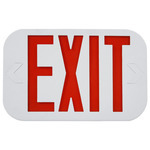Exit Signs
Exit Signs at 1000Bulbs.com
Though often overlooked until it's needed, exit and emergency lighting is required in any public space. Whether adding emergency exit signs to new construction or replacing old units, check for building code changes for updates on color and lighting requirements. Below are a few questions to ask when planning exit route lighting to ensure you get the right products for the job.
Correct Exit Sign Color: Red or Green?
If you live in Illinois or South Carolina, you're probably used to the standard red exit sign, while residents of Washington State, Michigan, and Indiana are more likely to see exit signs with green lettering. While the majority of states allow either color or allow it to be decided by each municipality, your local fire marshal can tell you which exit sign color is allowed in your location along with any other local fire codes. All exit signs at 1000Bulbs.com are OSHA compliant with lettering at least 6 inches high with a minimum 0.75 inch stroke.
Single or Double Face Fixtures?
Red or green lettering isn't the only thing to consider when adding or replacing your emergency lighting. Plan out the location for each sign to determine how many can be seen from two directions, for example on either end of a hallway with the emergency exit door in the middle of the hall. For those installations, you'll need a double face exit sign, with words and arrow knockouts on either side of the fixture. Single face signage can be used with the fixture is against or parallel to a wall. You also need to account for visibility. In many cases, a standard emergency exit sign is fine. For long hallways may require direct view LED exit signs with 100-300 ft. visibility.
Internal or External Illumination?
Not being able to see the sign indicating the nearest exit route defeats the purpose of having emergency exit lights. Therefore, proper illlumination of the sign is a must. While you can light a sign externally, using a spot light with battery backup so that the spotlight doesn't turn off during a power outtage, it's much simpler to have an internally lit sign like those offered here. Most of the time, it is the letters themselves that glow within the die-cast aluminum housing. Edge-lit signs work a little differently, with the light around the edge of the sign instead of the letters themselves. Photoluminescent exit signs are also an exception to the rule. These glow-in-the-dark signs require no electricity. An excellent choice for office buildings or parking structures, these light-emitting signs recharge during the day and glow at night. Visibility can range from 50-100 ft. Photoluminescent exit signs are not suited for all environments. Make sure to follow NFPA guidelines before purchasing. As with externally exit signage, a dedicated light source may be required if the ambient lighting is not enough to charge the sign.
Need Chevron Arrows?
On either side of the lettering, some exit signs have knockouts that when removed display an arrow or chevron pointing to the exit. These are required when the exit sign is pointing down a hallway or otherwise indicating an exit route that is not an immediate exit from the building or structure. Edge-lit signs and photoluminescent signs may not have these, so check each product if this is a required feature for a specific installation location.
What are the Maintenance Requirements?
Hard-wired emergency lights must be tested monthly for a minimum of 30 seconds. This includes emergency exit lights with a battery backup system. Those maintenance hours can add-up, so a self-testing exit sign is a low-cost alternative. These emergency lights perform routine checks every 30 days so instead of pressing and holding a button for 30 seconds on each sign, a visual inspection of the indicator light is all that is needed. Standalone battery-operated fire exit signs on the other hand only need to be tested yearly for a minimum of 90 minutes.




